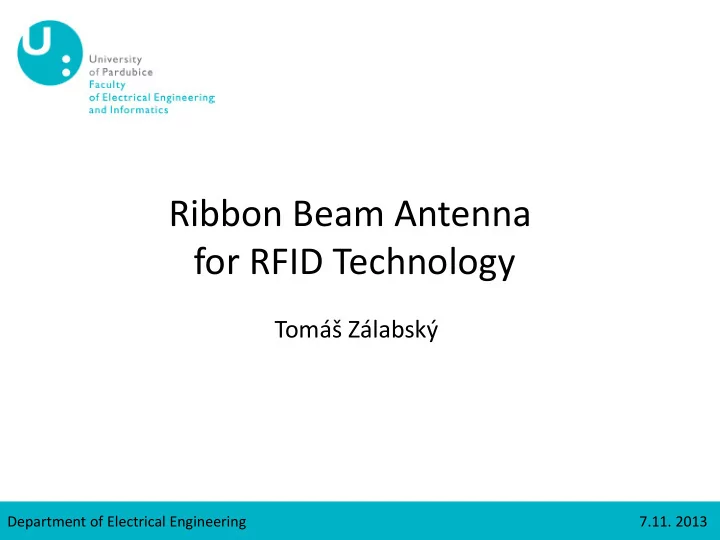

Ribbon Beam Antenna for RFID Technology Tomáš Zálabský Department of Electrical Engineering 7.11. 2013
INTRODUCTION • The developed antenna is a part of a railway information system. • This system consists of RFID tags situated on trains and of RFID readers located near to railway lines, communicating with an information center. • Nowadays antennas with circular radiation pattern in horizontal plane are used for these readers or in the ribbon radio networks. • These types of antennas do not use radiated power effectively because they radiate much power in the front direction. Another possibility is to use two Yagi antennas oriented to the • opposite sides along rails • This system has disadvantage in very low radiation in the transverse directions. • Normally the low coverage at short distances is not a problem but in our application (RFID) is necessary to cover near distances too. Department of Electrical Engineering 7.11. 2013 1
OBJECTIVES • The aim of this work was to design the antenna with cosecant radiation pattern on frequency 2.45 GHz. • This shape of the radiation pattern was chosen for the best coverage of the railway line In reality we can only approach to this curve because • a real antenna generates a rippled antenna response. Department of Electrical Engineering 7.11. 2013 2
MATERIAL & METHOD • Antenna system consists of two identical mirrors oriented antenna parts so we may design one part of the whole antenna only. • There are three dielectric layers. • On the top side of this layer a feeder circuit is situated consisting of power dividers of Wilkinson and branch-line types. • The second layer is made of a dielectric material and it is used for mechanical distance definition between the first and the third layer. • The third layer carrying radiating elements – patches. • Patch elements create the antenna array. Department of Electrical Engineering 7.11. 2013 3
RESULTS • The measured return loss of one patch element is shown. There is evident a good impedance match of the patch at the centre frequency. The return loss level is quite acceptable even in the range of 100 MHz. • The measured results of power dividers are presented on next picture. Department of Electrical Engineering 7.11. 2013 4
RESULTS • The measured reflection coefficient of the whole antenna system Průběh S-parametrů -5 S11 -10 -15 magnitude [dB] -20 -25 X: 2.448e+009 Y: -24.31 -30 -35 1 1.5 2 2.5 3 3.5 4 f [Hz] x 10 9 • The measured radiation pattern of the whole antenna structure Department of Electrical Engineering 7.11. 2013 5
ACKNOWLEDGEMENT & CONTACT Tomáš Zálabský tomas.zalabsky@student.upce.cz Department of Electrical Engineering Faculty of Electrical Engineering and Informatics University of Pardubice Czech Republic http://www.upce.cz/en/fei/ke.html The research was supported by the Internal Grant Agency of University of Pardubice, the project No. SGFEI 09/2013 and by the Czech Ministry of Industry and Trade, the research project No. FR TI-2/480. Department of Electrical Engineering 7.11. 2013 6
Recommend
More recommend